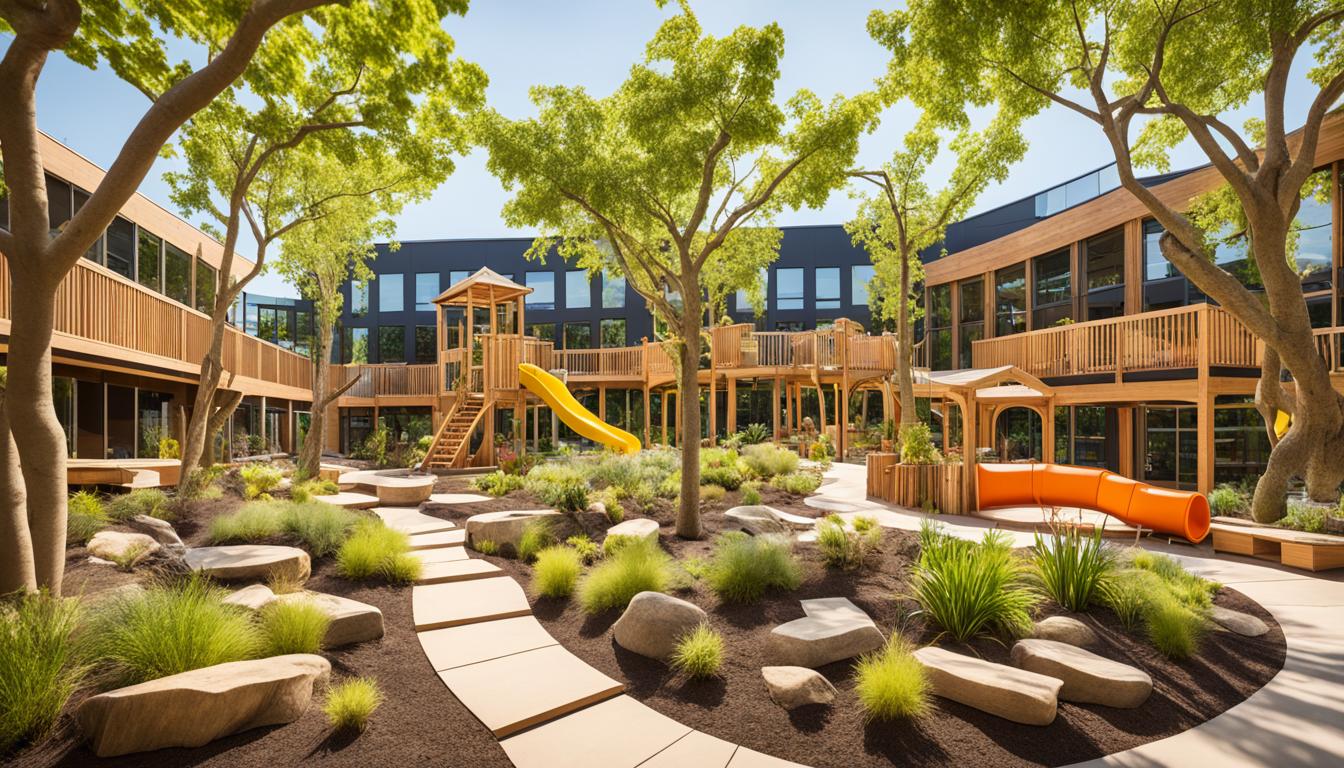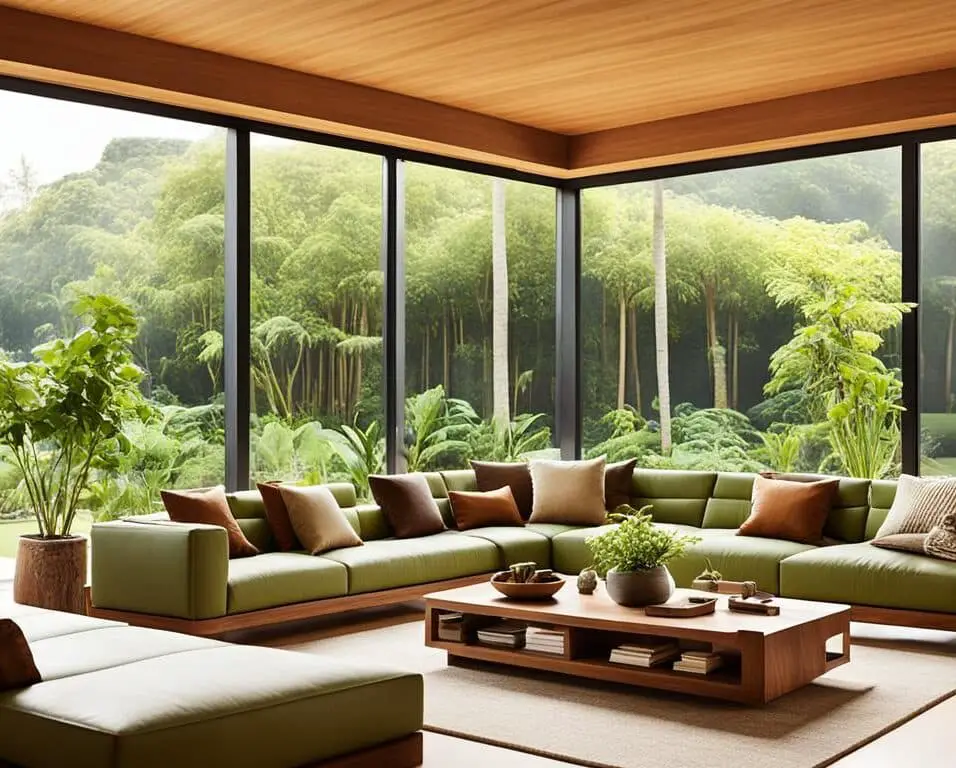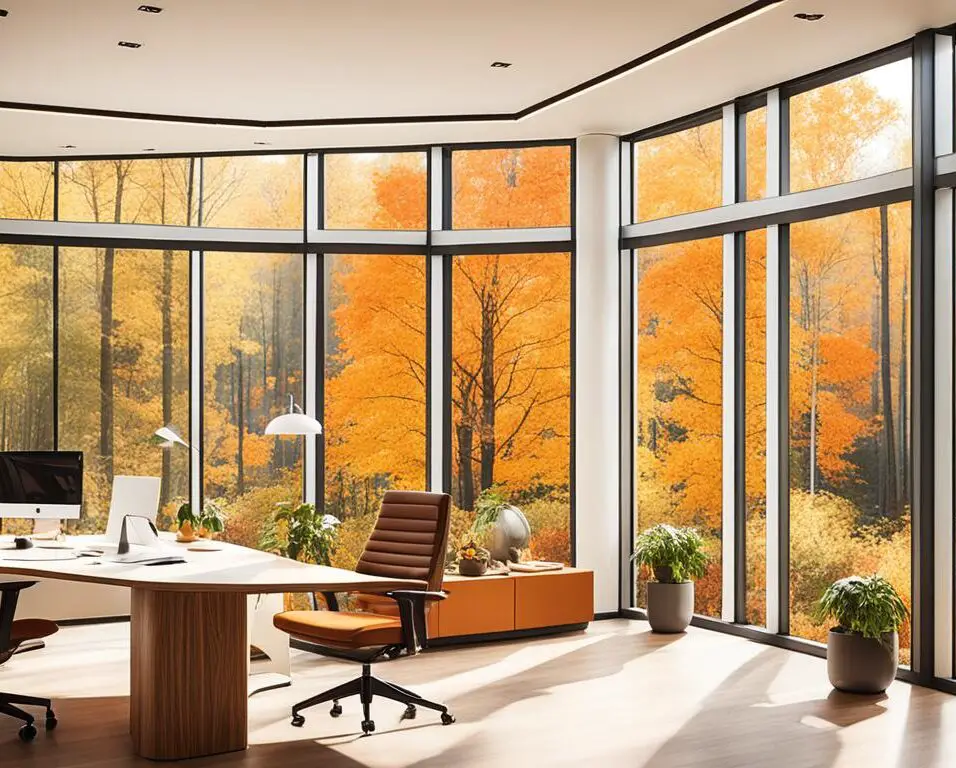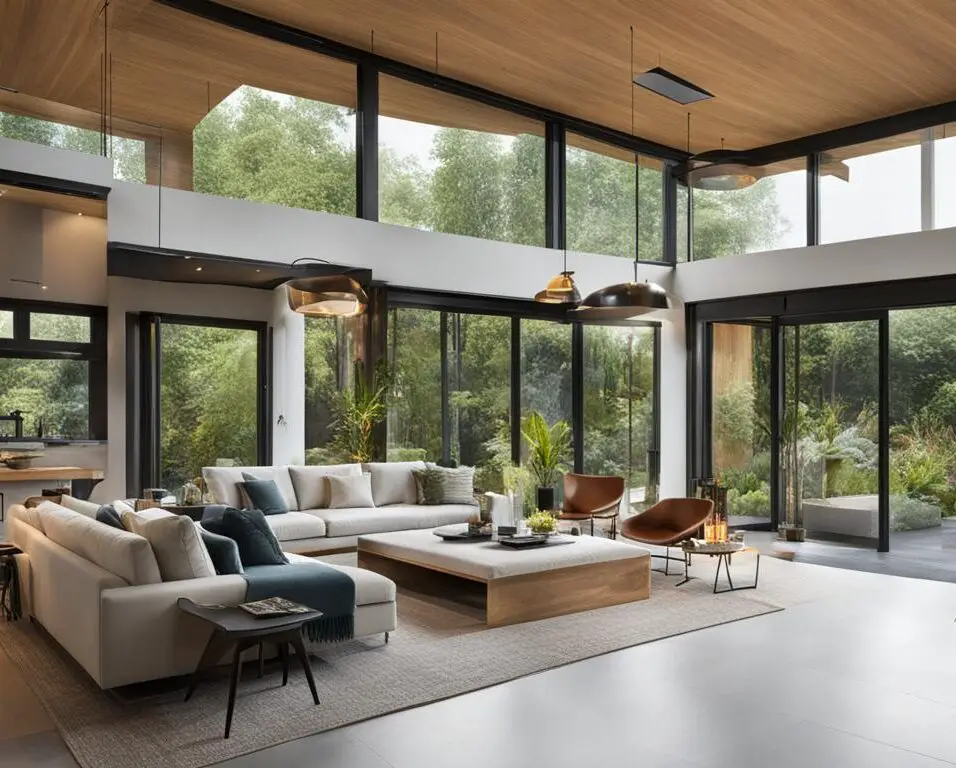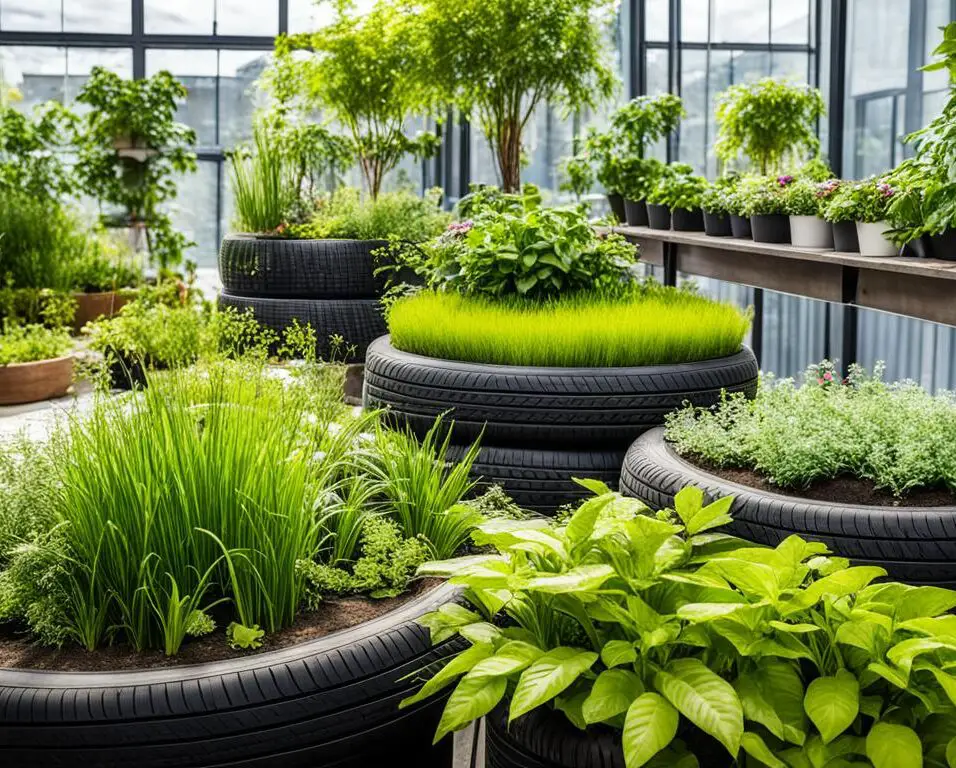Nature-Inspired Play: Biophilic Design for Child-Friendly Environments
Welcome to the world of biophilic design, where nature meets play and child-friendly environments come to life. As a professional copywriting journalist, I am delighted to share with you the exciting possibilities that biophilic design offers in nurturing growth and development in children. By integrating natural elements into our built environments, we can create spaces that captivate the imagination, promote well-being, and foster a deep connection to the world around us.
Biophilic design goes beyond aesthetics. It is an approach that recognizes the importance of nature in enhancing the quality of our lives. By incorporating elements such as natural light, greenery, and organic forms, child-friendly environments become more than just physical spaces – they become living, breathing, and ever-evolving places that stimulate curiosity, creativity, and exploration.
Key Takeaways:
- Biophilic design integrates natural elements to create nurturing environments for children.
- It promotes growth, well-being, and inclusivity.
- Nature-inspired play stimulates curiosity, creativity, and exploration.
- From natural light to organic forms, biophilic design enhances the quality of child-friendly spaces.
- Biophilic design fosters a deep connection between children and the natural world.
The Impact of Biophilic Design in Informal Settlements
In Kibera, one of the largest informal settlements in Kenya, the implementation of biophilic design principles has had a transformative impact. KDI, along with the community, embarked on a collaborative and inclusive design process to address the pressing issues of limited access to clean water, sanitation, and public space.
Through the lens of biophilic design, Kibera has witnessed the emergence of a dynamic and inclusive public space that caters to the needs of women, men, and children alike. This space has not only provided essential amenities but has also paved the way for social and cultural shifts within the community.
The redesigning of a dangerous bridge in Kibera serves as another example of the positive impact of biophilic design. The introduction of a new green thoroughfare has not only enhanced safety but has also managed to save time for the neighborhood women, facilitating their daily routines.
By prioritizing the integration of nature-inspired design elements and fostering community participation, KDI has successfully leveraged biophilic design to address the challenges faced by informal settlements. The key outcomes achieved through this approach have been a stronger sense of community, improved quality of life, and enhanced opportunities for women’s empowerment and leadership.
Gender Equity in Public Spaces and Transportation Systems
KDI’s work goes beyond transforming public spaces in informal settlements. In La Favorita Mendoza, Argentina, we focused on addressing gender equity through a community-led redesign process. The park, once deemed unsafe and unwelcoming for women and children, underwent a remarkable transformation. By engaging with community members and exploring multiple designs, we were able to create a park that is inclusive and accessible to everyone.

The new design incorporates features such as a playground, amphitheater, and community center that extend into the park, providing opportunities for engagement and social interaction. Women now have a safe and welcoming space where they can gather, exercise, and participate in community activities. This redesigned public space demonstrates our commitment to creating spaces that prioritize gender equity and inclusivity.
Our efforts to address gender equity extend beyond public spaces and into transportation systems. We recognize that women often face specific challenges when using public transportation, from safety concerns to inadequate facilities. In La Favorita Mendoza, we identified issues such as overcrowded buses and inadequate street lighting that disproportionately affected women.
To tackle these issues, we reimagined bus stops to be more than just waiting areas. Our redesigned bus stops now include bathrooms, kiosks, and lending libraries, creating a safer and more inclusive transportation experience for all. These improvements aim to alleviate some of the specific challenges faced by women when using public transportation, promoting gender equity and ensuring that everyone has equal access to essential services.
“By prioritizing gender equity in public spaces and transportation systems, we can create a more inclusive and accessible urban environment for everyone.”
By prioritizing gender equity in public spaces and transportation systems, we can create a more inclusive and accessible urban environment for everyone. Through our work in La Favorita Mendoza, we have demonstrated the transformative power of community-led design processes that prioritize the needs and experiences of women. Gender equity is not just an aspiration; it is a fundamental principle that should guide the planning and design of our public spaces and transportation networks.
Table: Examples of Gender Equity Interventions in Public Spaces and Transportation Systems
| Location | Intervention | Impact |
|---|---|---|
| La Favorita Mendoza, Argentina | Park redesign with inclusive features | Creation of a safe and welcoming space for women and children |
| La Favorita Mendoza, Argentina | Redesigned bus stops with bathrooms, kiosks, and lending libraries | Improved safety and accessibility for women using public transportation |
| City X, Country Y | Enhanced street lighting in areas with high foot traffic | Increased safety and visibility, particularly for women walking at night |
These examples demonstrate the varied approaches we take to promote gender equity in public spaces and transportation systems. By investing in inclusive design, we can create environments that empower and support the diverse needs of women and ensure that urban spaces are accessible and welcoming for all.
Creating Gender-Focused Neighborhood Mobility Plans
In the Eastern Coachella Valley of California, I have been working with the KDI team on a network of purpose-built public spaces and public transportation systems. Recognizing the importance of equitable access for all, we have implemented gender-focused neighborhood mobility plans to address the unique needs of different communities. Through a collaborative community design process, we have been able to make significant improvements to enhance mobility and inclusivity.
Improving Sidewalks for Multi-Modal Travel
One aspect of our gender-focused neighborhood mobility plans is the redesign of sidewalks. Recognizing that women often make shorter trips with multiple stops, we have widened sidewalks to accommodate various modes of transportation, such as walking, cycling, and the use of mobility devices. This multi-modal approach not only benefits women but also provides a more accessible and inclusive environment for individuals with disabilities and those who prefer alternative modes of transportation.
Empowering Women in the Design Process
Women from the Eastern Coachella Valley community have taken a leading role in shaping our gender-focused neighborhood mobility plans. They have actively participated in the design process to ensure that their specific needs and concerns are addressed. One standout example is the design of shade structures for bus stops. Women from the community led the design process, bringing attention to the importance of gender-inclusive design. These shade structures not only provide relief from the desert sun but also serve as a visual representation of the community’s commitment to creating safe and welcoming public spaces for everyone.
Women from the Eastern Coachella Valley community have shown incredible leadership and dedication in shaping our gender-focused neighborhood mobility plans. Their involvement has been instrumental in creating inclusive and equitable spaces that address the unique needs of our community.
To further highlight the impact of our gender-focused neighborhood mobility plans in the Eastern Coachella Valley, here is a table summarizing key improvements and their benefits:
| Improvement | Benefits |
|---|---|
| Widened sidewalks | – Enhanced accessibility for individuals with disabilities – Improved safety for pedestrians and cyclists – Facilitated multi-modal travel |
| Community-led shade structures for bus stops | – Increased visibility and recognition of women’s contributions – Provided a sense of safety – Created a welcoming and inclusive environment |
By actively considering gender equity and engaging community members in the design process, our gender-focused neighborhood mobility plans have made a positive impact in the Eastern Coachella Valley. These efforts contribute to creating a more inclusive, accessible, and sustainable transportation system that benefits all residents.
Incorporating Biophilic Design in Home Decor
Biophilic design principles can be seamlessly integrated into home decor, creating nurturing and nature-inspired spaces that benefit children’s well-being. By incorporating sustainable materials, such as bamboo, organic cotton, and reclaimed wood, we can not only add a natural quality to interiors but also promote environmental responsibility.
Embracing sustainable materials not only adds a natural quality to interiors but also promotes environmental responsibility.
For example, bamboo is a fantastic material to incorporate into home decor. It is fast-growing, renewable, and biodegradable, making it an eco-friendly choice. Bamboo furniture, flooring, or accents can bring a touch of nature into your home while reducing your carbon footprint.
Organic cotton is another sustainable material that can be used in home decor. It is grown without harmful pesticides and chemicals, making it safer for both the environment and your family’s health. Bedding, curtains, and upholstery made from organic cotton can provide a cozy and natural feel to your living spaces.
Reclaimed wood is a popular choice for creating rustic and environmentally friendly home decor. By repurposing old wood from barns, fences, or other structures, you can give new life to materials that would otherwise end up in landfills. Reclaimed wood furniture, accent walls, or decorative pieces add warmth and character to any room.
Integrating indoor greenery is another essential element of biophilic design in home decor. Potted plants or living walls not only enhance the aesthetics of the space but also improve indoor air quality and create a connection to nature.
Adding natural lighting enhancements further enhances the biophilic design principles in home decor. Sunlight streaming through windows provides warmth, illumination, and a direct link to the outdoors. Utilize curtains or blinds that allow ample natural light while maintaining privacy.
Soft pastel colors, accent colors and patterns inspired by nature, can be used to create a serene and inviting atmosphere. Earthy tones like greens, blues, and sandy neutrals are ideal for incorporating the calming effects of nature into your home decor.
Nature-Inspired Home Decor Ideas
- Create a living wall with a variety of indoor plants to bring nature indoors and improve air quality.
- Use natural materials like bamboo or reclaimed wood for furniture, flooring, and accents.
- Add organic cotton textiles like bedding, curtains, and upholstery for a soft and eco-friendly touch.
- Incorporate soft pastel colors inspired by nature, such as calming blues or gentle greens.
- Optimize natural lighting by utilizing sheer curtains or blinds that allow ample sunlight to filter through.
- Accessorize with nature-inspired patterns and textures, such as leaf prints or woven baskets.
“Nature offers endless inspiration for home decor. By incorporating biophilic design principles, we can create spaces that are not only visually appealing but also promote well-being and environmental stewardship.” – Home Design Expert
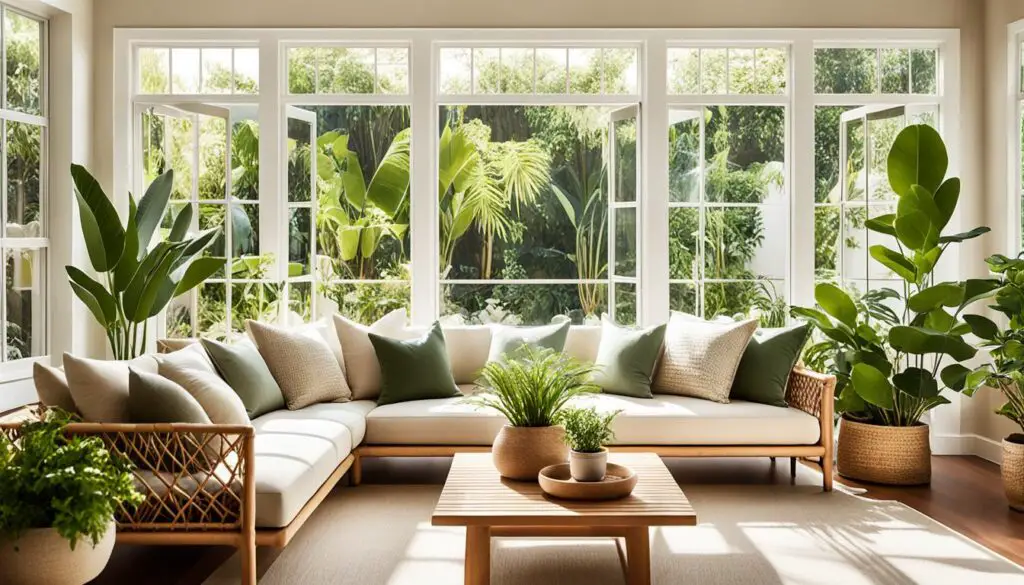
| Benefits of Biophilic Design in Home Decor |
|---|
| Promotes environmental responsibility through the use of sustainable materials. |
| Enhances indoor air quality by integrating indoor greenery. |
| Creates a serene and inviting atmosphere with soft pastel colors and natural lighting. |
By incorporating biophilic design principles into home decor, we can create spaces that not only reflect our connection to nature but also contribute to a sustainable and nurturing environment for children and families.
Conclusion
Biophilic design is a powerful approach for creating child-friendly environments that prioritize growth, well-being, and inclusivity. By incorporating natural elements, addressing gender equity in public spaces and transportation systems, and incorporating biophilic principles in home decor, we can create visually appealing and environmentally responsible spaces that nurture children’s development.
The work of organizations like KDI demonstrates the transformative impact of biophilic design in informal settlements and urban environments. By considering the diverse needs and experiences of individuals, these projects emphasize the importance of creating public spaces that are inclusive and accessible to all.
Looking ahead, biophilic design will continue to play a vital role in shaping child-friendly environments that support the well-being and development of children. Whether it’s through the integration of natural elements, the promotion of gender equity, or the adoption of sustainable materials, biophilic design offers endless possibilities for creating spaces that inspire nature-inspired play and foster a sense of connection to the natural world.
FAQ
What is biophilic design?
Biophilic design is a design approach that focuses on integrating natural elements into child-friendly environments to create spaces that nurture growth and development.
Who does biophilic design benefit?
Biophilic design aims to create spaces that are just, inclusive, and accessible for everyone, including women, LGBTQIA+ individuals, people with disabilities, and people of color.
How does biophilic design promote social and economic well-being?
By understanding who feels safe and comfortable in public spaces, landscape architects and planners can work towards creating equitable and inclusive environments, which in turn promote social and economic well-being.
Can you provide an example of biophilic design in action?
One example is the work of the Kounkuey Design Initiative (KDI) in Kibera, Kenya, where they implemented biophilic design principles to address the lack of access to clean water, sanitation, and public space and co-designed and co-built a dynamic public space that is equally accessible to women, men, and children.
How does biophilic design address gender equity in public spaces?
Biophilic design takes into consideration the needs and experiences of all individuals and works towards creating safer and more inclusive public spaces that benefit everyone, including women.
In what ways does biophilic design incorporate nature into home decor?
Biophilic design in home decor embraces sustainable materials such as bamboo, organic cotton, and reclaimed wood, integrates indoor greenery through potted plants and living walls, and incorporates natural lighting enhancements, creating nurturing and nature-inspired spaces for children.
How does biophilic design support the well-being and development of children?
Biophilic design creates child-friendly environments that promote growth and well-being by integrating natural elements, addressing gender equity in public spaces and transportation systems, and incorporating biophilic principles in home decor.



